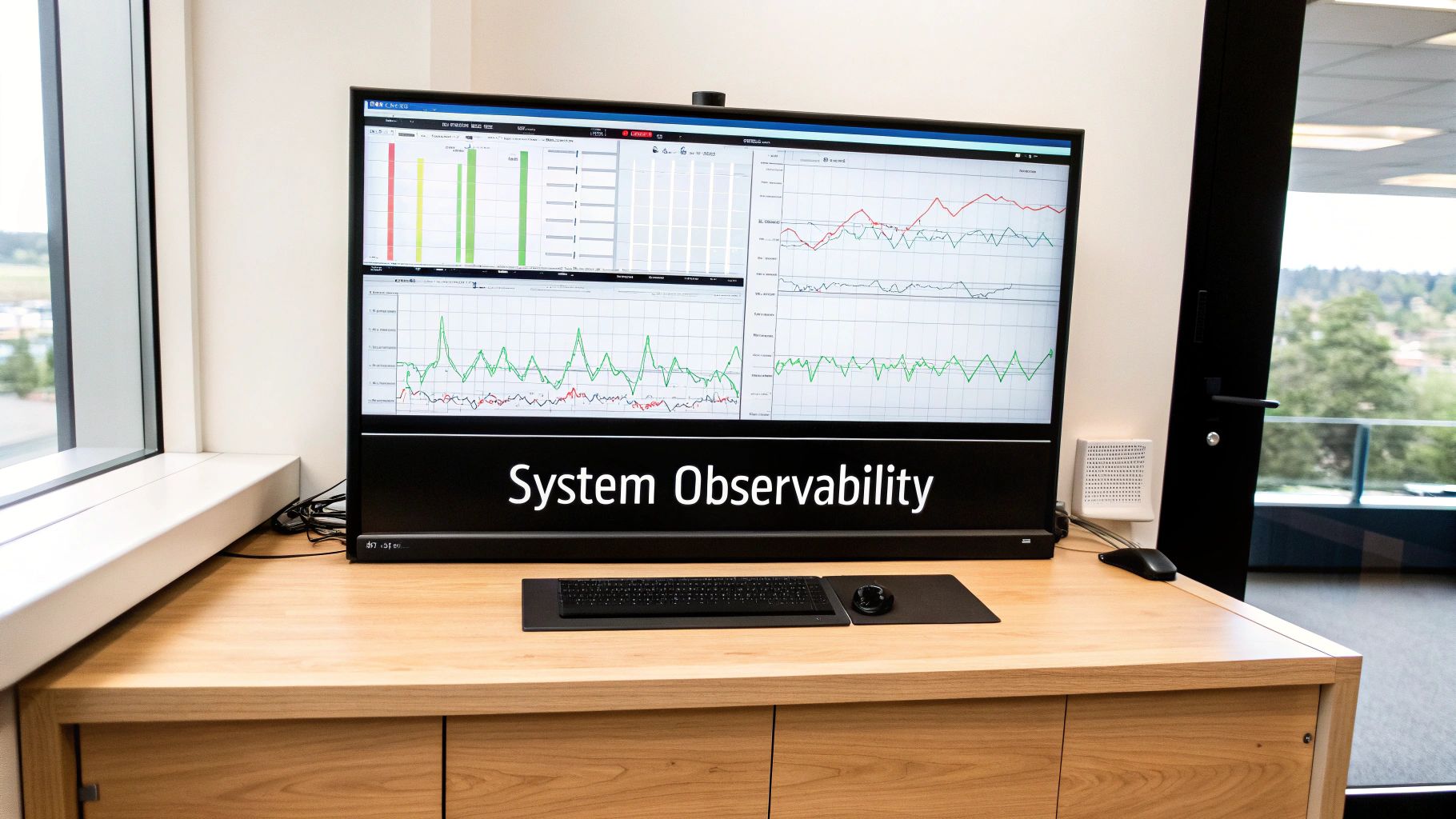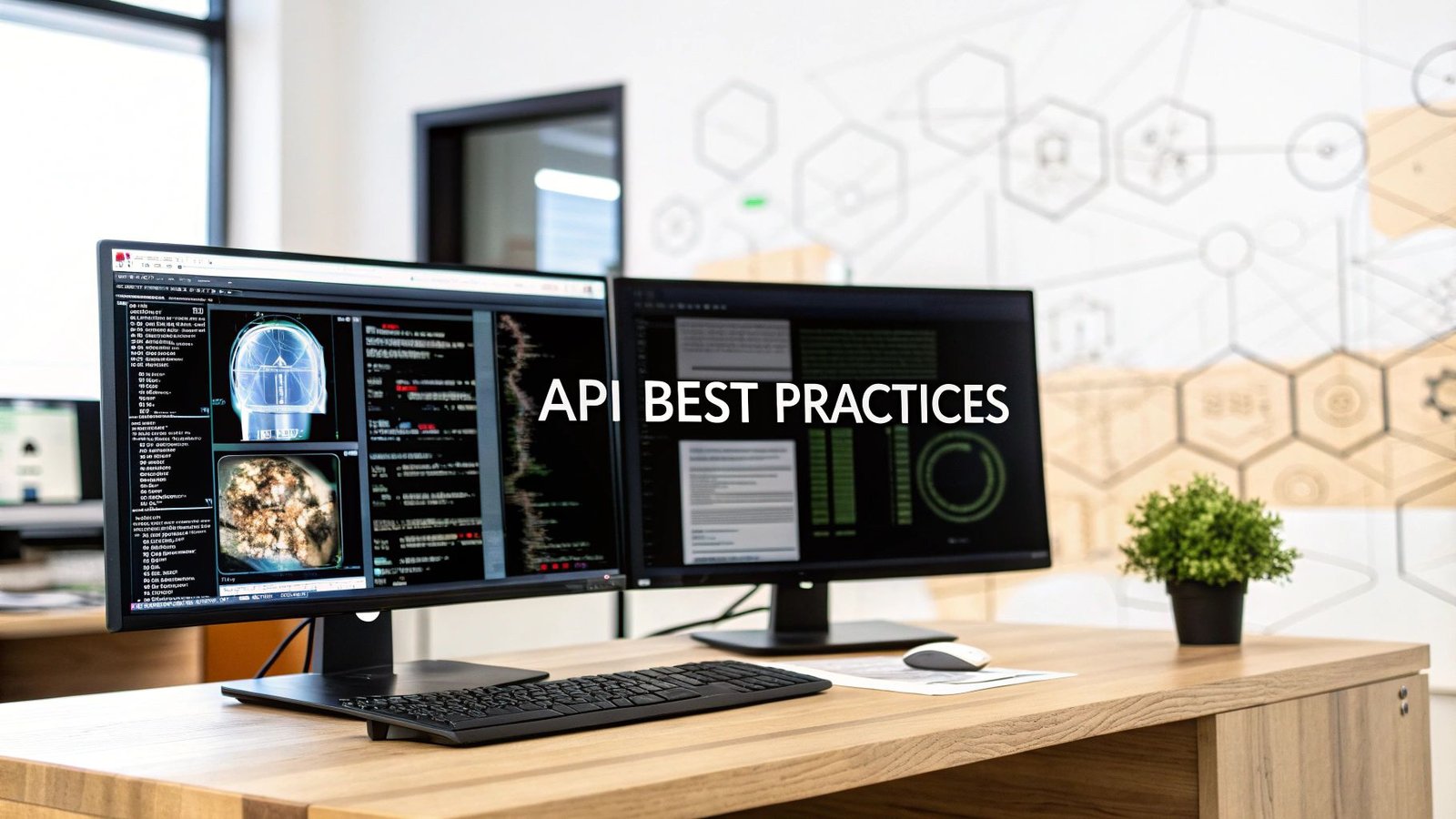In an era of interconnected digital health, the power of an application is defined by its ability to communicate. Application Programming Interfaces (APIs) are the engines of this communication, the invisible yet indispensable threads weaving together complex systems. From advanced medical imaging platforms to electronic health records, robust APIs are no longer a technical luxury but a foundational necessity for innovation and interoperability. They are the unseen backbone that supports the seamless exchange of critical healthcare data, enabling faster diagnostics, better patient outcomes, and more efficient workflows.
But what separates a functional API from a truly exceptional one? The difference lies in a disciplined commitment to excellence, a philosophy we live by at PYCAD when we build custom web DICOM viewers and integrate them into medical imaging web platforms for our clients. It’s about building a digital handshake that is not only firm and reliable but also intuitive and secure. This guide is your blueprint for achieving that excellence. We will explore 10 non-negotiable api development best practices that transform your services from mere data conduits into secure, scalable, and developer-friendly powerhouses.
This is not a theoretical overview; it's an actionable playbook. You will learn the essentials of RESTful design, security, versioning, documentation, and performance. By mastering these principles, you ensure your technology not only meets today's rigorous demands but is also resilient enough for the healthcare innovations of tomorrow. Let’s build APIs that inspire confidence and drive progress.
1. RESTful API Design Principles
The foundation of any robust, scalable API often lies in the principles of Representational State Transfer (REST). More than just a technology, REST is an architectural style that leverages standard HTTP protocols to create predictable and intuitive APIs. It treats every piece of data as a resource that can be uniquely identified, accessed, and modified through a common interface, making it a cornerstone of modern API development best practices.

This approach promotes stateless communication, meaning each request from a client contains all the information needed for the server to fulfill it. This decouples the client and server, allowing them to evolve independently. For medical imaging platforms handling sensitive patient data, this separation is critical for security and scalability. Adopting these principles ensures your API is not just functional but also a delight for developers to integrate with, as seen in the clear and consistent APIs from giants like Stripe and GitHub.
Actionable Implementation Tips
To harness the power of REST, focus on these practical steps:
- Use Nouns for Resources: Structure your endpoints around the "things" your API manages. For instance, use
/patientsto represent a collection of patients and/patients/{id}for a specific patient. - Leverage HTTP Methods: Employ standard HTTP verbs for actions. Use
GETfor retrieval,POSTfor creation,PUTorPATCHfor updates, andDELETEfor removal. For a deeper dive, explore understanding PUT vs. PATCH methods to choose the right verb for your update operations. - Provide Clear Feedback: Utilize standard HTTP status codes to communicate outcomes. A
201 Createdis more informative than a generic200 OKafter a resource is created, while a404 Not Foundclearly indicates a missing resource. - Plan for Growth with Versioning: Incorporate versioning from the start, such as
api.yourdomain.com/v1/patients, to introduce changes without breaking existing integrations.
By embracing RESTful design, you create a logical and consistent framework that accelerates development and simplifies maintenance. These principles are fundamental to building powerful systems, such as the Google Cloud Healthcare API, which manages complex medical data at scale. At PYCAD, we leverage these best practices when we build custom web DICOM viewers and integrate them into medical imaging web platforms, ensuring our solutions are both powerful and easy to use. Explore our work on our portfolio page.
2. API Authentication & Authorization
Securing your API is not an afterthought; it's a fundamental requirement, especially in the healthcare and medical imaging space where data sensitivity is paramount. Robust authentication confirms the identity of who is making a request, while authorization determines what they are allowed to do. Together, these two pillars form the gatekeepers of your API, ensuring only legitimate users can access protected resources and perform permitted actions, safeguarding critical patient information.

Implementing strong security measures prevents unauthorized access, data breaches, and misuse of services. This is a non-negotiable aspect of api development best practices. Platforms like Auth0 and Google's OAuth 2.0 provide battle-tested frameworks that streamline this complex process. By integrating these solutions, you build a fortress around your data, fostering trust with users and partners who rely on your system's integrity, much like AWS IAM secures an entire cloud ecosystem.
Actionable Implementation Tips
To effectively secure your API, focus on these critical steps:
- Use OAuth 2.0 for Delegated Access: When allowing third-party applications to access user data, OAuth 2.0 is the industry standard. It enables secure, delegated access without sharing user credentials.
- Implement JWT with Short Expiration: Use JSON Web Tokens (JWT) for stateless authentication. Set short expiration times (e.g., 15-30 minutes) and use refresh tokens to maintain sessions securely.
- Enforce HTTPS Always: Mandate HTTPS (TLS) for all API communications to encrypt data in transit, preventing man-in-the-middle attacks from intercepting tokens or sensitive information.
- Store Secrets Securely: Never hardcode API keys, client secrets, or other credentials in your source code. Use environment variables or a dedicated secrets management service like HashiCorp Vault.
By prioritizing authentication and authorization, you build a resilient and trustworthy API. At PYCAD, when we build custom web DICOM viewers and integrate them into medical imaging web platforms, we implement these rigorous security protocols to protect sensitive health data. Explore our secure solutions on our portfolio page.
3. Comprehensive API Documentation
An API, no matter how powerful, is only as good as its documentation. Comprehensive API documentation acts as the ultimate user manual, guiding developers through every step of integration, from authentication to handling specific endpoints. It transforms a complex tool into an accessible resource, drastically reducing the learning curve and accelerating adoption. This is one of the most critical, yet often overlooked, API development best practices.

Clear, accurate, and interactive documentation empowers developers to succeed without constant support, fostering a self-sufficient ecosystem around your product. For teams in the medical imaging space, this means faster integration of tools like DICOM viewers into existing EMR or PACS systems. Industry leaders like Stripe and Twilio set the gold standard, providing documentation that is not just informative but an integral part of their developer experience. Their success proves that investing in documentation is investing in your API's future.
Actionable Implementation Tips
To create documentation that inspires and enables, implement these strategies:
- Standardize with OpenAPI: Use the OpenAPI Specification (formerly Swagger) to create a machine-readable definition of your API. This serves as a single source of truth and can automatically generate interactive documentation, client SDKs, and server stubs.
- Provide Runnable Examples: For every endpoint, include practical, copy-and-paste code snippets in multiple popular languages (e.g., Python, JavaScript, cURL). This allows developers to see your API in action immediately.
- Document Every Response: Detail all possible success and error responses with clear examples. Explaining what a
403 Forbiddenerror means in the context of a specific endpoint saves developers hours of debugging. - Use Interactive Consoles: Integrate tools like Swagger UI or ReDoc to allow developers to make live API calls directly from the documentation. This hands-on experience is invaluable for understanding how your API behaves.
- Maintain a Detailed Changelog: Keep a public, up-to-date changelog that clearly outlines new features, bug fixes, and breaking changes for each version of your API.
By treating documentation as a first-class product, you build trust and drive adoption. At PYCAD, we understand that seamless integration is key when we build custom web DICOM viewers and integrate them into medical imaging web platforms. Well-documented APIs ensure our solutions fit perfectly into our clients' existing workflows. See examples of our integration work on our portfolio page.
4. Input Validation & Data Sanitization
An API is a gateway to your application's data and logic, making it a prime target for malicious actors. Rigorous input validation and data sanitization form the first line of defense, acting as a vigilant security guard that inspects every piece of data before it enters your system. This practice involves strictly defining and enforcing rules for incoming data, preventing common vulnerabilities like SQL injection, cross-site scripting (XSS), and data corruption.
This defensive approach is non-negotiable, especially in healthcare technology where data integrity is paramount. By treating all incoming data as untrusted by default, you ensure that only clean, expected, and safe information is processed. This principle, heavily promoted by security standards like the OWASP Top 10, transforms your API from a potential vulnerability into a fortified, resilient system. It's a foundational element of secure API development best practices that protects both your infrastructure and the sensitive data it handles.
Actionable Implementation Tips
To build a robust defense through validation and sanitization, implement these critical steps:
- Always Validate on the Server: Never trust client-side validation alone, as it can be easily bypassed. All validation logic must reside on the server to be effective.
- Use Established Libraries: Leverage battle-tested validation libraries for your framework, such as
express-validatorfor Node.js or the built-in validators in Django REST Framework and ASP.NET Core. These tools simplify the process and cover numerous edge cases. - Implement Whitelist Validation: Instead of trying to block a long list of known bad inputs (blacklisting), define exactly what is allowed (whitelisting). For example, only permit alphanumeric characters and specific symbols in a username field.
- Validate Multiple Data Aspects: Check for type (e.g., string, integer), length (min/max characters), format (e.g., email, date), and range (e.g., a value between 1 and 100).
- Sanitize All User Content: Before storing or displaying any user-generated content, sanitize it to neutralize potentially harmful scripts or code.
- Use Parameterized Queries: To prevent SQL injection, always use parameterized queries or prepared statements when interacting with your database. This ensures user input is treated as data, not as executable code.
At PYCAD, we prioritize these security measures when we build custom web DICOM viewers. By validating every request and sanitizing all data, we ensure our medical imaging web platforms are secure and reliable. See the secure solutions we've delivered on our portfolio page.
5. Automated API Testing
While a well-designed API is a great start, its long-term reliability hinges on rigorous and continuous validation. Automated API testing is the practice of using software to automatically check an API's functionality, performance, and security. This systematic approach moves beyond manual checks to create a safety net that catches regressions, validates business logic, and ensures the API behaves exactly as specified, even as the codebase evolves.
Automated testing is the guardian of your API's integrity. It ensures that every new feature or bug fix doesn't inadvertently break existing functionality. For healthcare platforms managing critical patient data workflows, this level of assurance is not just a best practice; it's a necessity. This discipline allows teams to deploy changes with confidence, knowing that a comprehensive suite of tests has verified the system's stability, much like the automated quality checks in medical device manufacturing.
Actionable Implementation Tips
To build a resilient and reliable API, integrate these automated testing strategies:
- Embrace the Test Pyramid: Structure your tests with a wide base of fast unit tests, a smaller layer of integration tests, and a very selective set of end-to-end tests. This model, championed by thought leaders like Martin Fowler, ensures efficient and effective coverage.
- Test All Scenarios: Go beyond the "happy path." Write tests for edge cases, invalid inputs, and potential error conditions to ensure your API handles unexpected situations gracefully and securely.
- Isolate Your Tests: Use mocks and stubs to isolate the API from external dependencies like databases or third-party services. This makes tests faster, more reliable, and focused solely on your API's logic. For a powerful framework that excels in both UI and direct API testing, refer to this guide on modern Playwright API testing.
- Automate Performance and Security: Integrate performance load testing and security scans (like checking for OWASP Top 10 vulnerabilities) directly into your CI/CD pipeline. This proactively identifies bottlenecks and security flaws before they reach production.
By making automated testing a core part of your API development best practices, you build a more robust, secure, and maintainable system. At PYCAD, we implement comprehensive testing for every custom web DICOM viewer we build, ensuring our medical imaging platforms are dependable from day one. See the quality of our work on our portfolio page.
6. Proper Error Handling & Standardized Error Responses
Even the most well-designed API will encounter errors. How you communicate these failures is a critical, yet often overlooked, aspect of the developer experience. Proper error handling with standardized responses transforms frustrating bugs into solvable problems, empowering developers to diagnose and fix issues efficiently without needing to contact your support team. It’s a cornerstone of reliable API development best practices.
This approach involves creating a consistent and predictable error format across all endpoints. Instead of cryptic messages, a well-structured error response provides clear, actionable information. This not only aids human debugging but also allows client applications to programmatically handle failures gracefully, improving the resilience of the entire system. For medical imaging platforms where a failed request could impact patient data access, this level of clarity and predictability is non-negotiable. Leading APIs like Stripe's excel at this, providing detailed error objects that turn moments of failure into opportunities for learning and quick resolution.
Actionable Implementation Tips
To build a robust and developer-friendly error handling system, focus on these key strategies:
- Use Standard HTTP Status Codes: Align your responses with standard HTTP status codes. Use
400for client-side validation errors,401for authentication issues,404for missing resources, and500for unexpected server-side problems. - Create a Consistent Error Payload: Define a standard JSON object for all error responses. Include fields like a unique
errorCodefor programmatic handling, a human-readablemessage, and arequestIdto correlate with server-side logs for faster debugging. - Provide Actionable Messages: Error messages should guide the developer toward a solution. Instead of "Invalid Input," use "The 'patientId' field is required and must be a valid UUID."
- Never Expose Sensitive Data: Ensure error responses do not leak internal system details, stack traces, or database information, as this can create significant security vulnerabilities.
- Log Everything Server-Side: While the client receives a clean error, your server should log the full context, including the stack trace and request details, to facilitate thorough debugging by your team.
By implementing a thoughtful error handling strategy, you build trust and make your API more resilient. At PYCAD, when we build custom web DICOM viewers and integrate them into medical imaging web platforms, we design our APIs with clear, standardized error responses to ensure reliability and ease of integration for our healthcare partners. See examples of our robust solutions on our portfolio page.
7. API Versioning Strategy
An API is a living product that must evolve to meet new demands, incorporate new features, and fix imperfections. This evolution, however, can introduce "breaking changes" that disrupt existing integrations. An effective API versioning strategy is the critical practice that allows your API to grow and improve without abandoning the developers and applications that rely on it, making it a non-negotiable part of any robust API development best practices.
This strategic approach to change management ensures backward compatibility and provides a predictable, stable experience for your consumers. It signals a commitment to your developer community, building trust and encouraging long-term adoption. For healthcare systems, where an unexpected API change could impact patient care workflows or data access, a clear versioning policy is not just a best practice; it's an operational necessity. Industry leaders like Stripe and GitHub have demonstrated how thoughtful versioning fosters a healthy, thriving developer ecosystem.
Actionable Implementation Tips
To manage your API's lifecycle gracefully, implement these versioning tactics:
- Choose a Clear Versioning Scheme: The most common and recommended approach is to include the version number directly in the URL path (e.g.,
/api/v1/patients). This method is explicit and straightforward for developers to understand and use. - Establish a Deprecation Policy: Clearly communicate how long older versions will be supported. A standard practice is to provide a 12-18 month notice period before sunsetting an old version, giving consumers ample time to migrate.
- Document Changes Meticulously: Maintain a detailed changelog for each new version. Highlight breaking changes, new features, and bug fixes to make the migration process as smooth as possible for developers.
- Support Multiple Versions Concurrently: To avoid forcing immediate upgrades, support at least the current and one previous major version (n-1). This provides flexibility and reduces pressure on your consumers.
By adopting a formal versioning strategy, you ensure your API can adapt to the future while respecting the integrations of the past. This forward-thinking approach is essential for achieving the kind of seamless data exchange required for true data interoperability in healthcare. At PYCAD, we implement versioning from day one when we build custom web DICOM viewers, ensuring the medical imaging platforms we create are stable and future-proof. See our commitment to robust development on our portfolio page.
8. Rate Limiting & Throttling
A robust API must not only serve valid requests but also protect itself from overwhelming traffic, whether malicious or accidental. This is where rate limiting and throttling come into play, serving as essential guardians of your infrastructure. By controlling the number of requests a client can make within a specific time window, you ensure fair resource distribution, prevent denial-of-service (DoS) attacks, and maintain high availability for all users.
This practice is non-negotiable for APIs handling critical operations, such as a medical imaging platform processing large DICOM files. Unchecked requests could easily overwhelm servers, leading to system-wide failures. By implementing intelligent limits, as demonstrated by industry leaders like GitHub and Stripe, you create a stable, predictable environment. This proactive defense is a cornerstone of professional API development best practices, ensuring your service remains reliable under pressure.
Actionable Implementation Tips
To effectively implement rate limiting and throttling, consider these strategic steps:
- Communicate Limits Clearly: Use
X-RateLimitheaders in every API response (X-RateLimit-Limit,X-RateLimit-Remaining,X-RateLimit-Reset) to inform developers of their current status. - Return a Specific Status Code: When a limit is exceeded, respond with a
429 Too Many Requestsstatus code. This provides unambiguous feedback for client-side error handling. - Implement Tiered Access: Offer different rate limits for various user tiers (e.g., unauthenticated, free, premium). This allows you to scale resources according to user value and prevent abuse from anonymous traffic.
- Consider Request Weight: Not all requests are equal. Assign a higher "cost" or weight to computationally intensive operations, such as complex image processing queries, and deplete the rate limit accordingly.
Implementing these controls is vital for the stability of high-throughput systems. At PYCAD, when we build custom web DICOM viewers and integrate them into medical imaging web platforms, we engineer our APIs with sophisticated rate-limiting policies. This ensures the platforms we develop can handle demanding workflows without compromising performance, a testament to our commitment to resilient architecture. Discover our work on our portfolio page.
9. Monitoring, Logging & Observability
Building a powerful API is only the beginning; keeping it reliable and performant requires deep visibility into its inner workings. This is where monitoring, logging, and observability become indispensable. These practices transform your API from a black box into a transparent system, allowing you to track performance, diagnose issues proactively, and understand user behavior. True observability goes beyond simple error logs; it’s about asking any question about your system's state and getting an answer.

This trifecta of logging, metrics, and tracing provides a complete picture of your API's health. For a medical imaging platform transferring large DICOM files, understanding latency spikes or failed requests in real-time is crucial for patient care and diagnostics. Platforms like Datadog and New Relic have popularized this holistic approach, enabling teams to move from reactive troubleshooting to proactive performance optimization, a core principle of modern api development best practices.
Actionable Implementation Tips
To build a truly observable system, integrate these essential strategies:
- Implement Structured Logging: Use a consistent format like JSON for your logs. This makes them machine-readable, enabling easier searching, filtering, and analysis with tools like the ELK Stack (Elasticsearch, Logstash, Kibana).
- Use Correlation IDs for Tracing: Include a unique identifier in every request that propagates through all your microservices. This allows you to trace a single user action across the entire system, which is invaluable for debugging complex workflows.
- Log at Appropriate Levels: Differentiate log messages using levels such as
DEBUG,INFO,WARN, andERROR. This helps filter out noise and focus on critical issues when troubleshooting. - Establish Key Performance Metrics: Monitor essential metrics like request rate, error rate, and latency (p95, p99). Use tools like Prometheus to collect these metrics and set up alerts for when they cross predefined thresholds.
- Create Health Check Endpoints: Implement a dedicated endpoint, like
/health, that orchestration tools can use to verify the API's operational status automatically.
By embedding observability into your development lifecycle, you ensure your API remains robust and dependable. At PYCAD, we apply these principles when we build custom web DICOM viewers, ensuring the systems we integrate into medical imaging web platforms are not just powerful but also transparent and maintainable. See our successful integrations on our portfolio page.
10. API Security Best Practices
In an era where data is the new currency, API security is not a feature but a fundamental necessity. It encompasses a multi-layered strategy to protect your endpoints from an ever-growing landscape of threats, including unauthorized access, data breaches, and denial-of-service attacks. A secure API builds trust and ensures the integrity and confidentiality of the data it handles, which is non-negotiable in medical imaging and healthcare.
This holistic approach means baking security into every phase of the API lifecycle, from design to deployment and maintenance. For platforms handling sensitive patient health information (PHI), this proactive stance is critical for regulatory compliance and protecting patient privacy. Leading platforms like Stripe, which manages financial transactions, and AWS API Gateway, with its built-in security features, demonstrate that robust security is a core pillar of a successful and trustworthy API, making it an essential part of API development best practices.
Actionable Implementation Tips
To fortify your API and protect sensitive data, integrate these security measures:
- Enforce Encrypted Communication: Always use HTTPS with the latest TLS protocol (e.g., TLS 1.2+). This encrypts data in transit, preventing eavesdropping and man-in-the-middle attacks.
- Implement Strong Authentication & Authorization: Use robust mechanisms like OAuth 2.0 to control who can access your API and what they are allowed to do. Ensure permissions are granular and follow the principle of least privilege.
- Utilize Security Headers: Configure headers like HSTS (HTTP Strict Transport Security),
X-Content-Type-Options, andX-Frame-Optionsto protect against common web vulnerabilities like cross-site scripting (XSS) and clickjacking. - Manage Secrets and Keys Securely: Never hardcode credentials. Use a secure vault for storing API keys and secrets, and implement a policy for regular key rotation to limit the window of opportunity for attackers.
- Protect Sensitive Data: When dealing with PHI, data protection is paramount. Explore techniques like data anonymization to remove personally identifiable information before it is processed or stored. You can learn more about data anonymization to enhance your data protection strategy.
By adopting these security-first principles, you build resilient APIs that users and partners can trust. At PYCAD, we integrate these rigorous security standards when we build custom web DICOM viewers and integrate them into medical imaging web platforms, ensuring our solutions are secure and compliant. Discover our commitment to excellence on our portfolio page.
10-Point API Best Practices Comparison
| Item | Implementation Complexity 🔄 | Resource Requirements ⚡ | Expected Outcomes ⭐ | Ideal Use Cases 💡 | Key Advantages 📊 |
|---|---|---|---|---|---|
| RESTful API Design Principles | 🔄🔄 — Moderate (routing, versioning) | ⚡⚡ — Low to moderate (HTTP infra) | ⭐⭐⭐⭐ — Predictable, scalable endpoints | Public APIs, CRUD services, cacheable resources | Simple HTTP semantics; cacheable; framework-agnostic |
| API Authentication & Authorization | 🔄🔄🔄 — High (flows, token management) | ⚡⚡⚡ — Moderate to high (identity infra) | ⭐⭐⭐⭐ — Secure, fine-grained access control | Production APIs, third‑party integrations, sensitive data | Standard protocols (OAuth2, JWT); fine-grained control |
| Comprehensive API Documentation | 🔄🔄 — Moderate (specs + examples) | ⚡⚡ — Ongoing editorial + tooling effort | ⭐⭐⭐⭐ — Better adoption, fewer support requests | Developer portals, public APIs, onboarding workflows | Improves adoption; enables SDKs and interactive testing |
| Input Validation & Data Sanitization | 🔄🔄🔄 — High (rules, sanitizers) | ⚡⚡ — Moderate (libraries, runtime cost) | ⭐⭐⭐⭐⭐ — Prevents vulnerabilities, improves reliability | Any API accepting user input; security‑sensitive endpoints | Prevents SQLi/XSS; reduces data corruption and errors |
| Automated API Testing | 🔄🔄 — Moderate (tests, CI integration) | ⚡⚡ — Moderate (CI/CD, test infra) | ⭐⭐⭐⭐ — Fewer regressions; higher deployment confidence | CI/CD pipelines, frequent releases, microservices | Catches bugs early; enables safe refactoring |
| Proper Error Handling & Standardized Error Responses | 🔄🔄 — Moderate (consistency rules) | ⚡ — Low (formatting + logging) | ⭐⭐⭐ — Clearer debugging and programmatic handling | Public APIs, distributed services, support-heavy products | Improves debugging; reduces support overhead |
| API Versioning Strategy | 🔄🔄🔄 — Moderate to high (supporting versions) | ⚡⚡⚡ — Moderate (testing + maintenance) | ⭐⭐⭐⭐ — Backward compatibility; controlled evolution | APIs with breaking changes or long-lived clients | Smooth migrations; clear change communication |
| Rate Limiting & Throttling | 🔄🔄 — Moderate (algorithms + enforcement) | ⚡⚡⚡ — Moderate to high (caching/gateway) | ⭐⭐⭐⭐ — Protects infra; enforces fair use | Public APIs, tiered pricing, high-traffic endpoints | Prevents DoS; enforces quotas; supports tiers |
| Monitoring, Logging & Observability | 🔄🔄🔄 — High (tracing + metrics) | ⚡⚡⚠️⚡ — High (storage, tooling, dashboards) | ⭐⭐⭐⭐⭐ — Fast detection; performance insights | Production systems, microservices, SRE operations | Enables debugging, alerting, and performance tuning |
| API Security Best Practices | 🔄🔄🔄🔄 — Very high (holistic security) | ⚡⚡⚡⚡ — High (tools, audits, upkeep) | ⭐⭐⭐⭐⭐ — Reduced breach risk; compliance readiness | Regulated industries, sensitive data, public APIs | Comprehensive protection; builds trust and compliance |
From Principles to Practice: Your Next Steps in API Excellence
We've journeyed through the foundational pillars of exceptional API development, from the clean architecture of RESTful design to the vigilant oversight of advanced monitoring. This exploration of API development best practices is more than a simple checklist; it's a strategic blueprint for building digital infrastructure that is robust, secure, and prepared for the future. The principles of rigorous authentication, comprehensive documentation, and intelligent versioning are not just technical details. They are the very bedrock upon which reliable, scalable, and trustworthy systems are built.
In the high-stakes environment of medical imaging and healthcare technology, this commitment to excellence takes on a profound significance. An API is not merely a conduit for data; it's a critical lifeline connecting diagnostic tools, patient records, and clinical workflows. A well-designed API ensures that a radiologist can access a DICOM image instantly, that patient data remains secure and confidential, and that a new diagnostic algorithm can be integrated seamlessly into an existing platform. The difference between a poorly implemented API and one built on these best practices can be the difference between a fragmented, vulnerable system and a cohesive, secure ecosystem that empowers healthcare providers and improves patient care.
Turning Knowledge into Action
The path from understanding these principles to mastering them is paved with intentional action. Merely acknowledging the importance of automated testing or proper error handling is not enough. The real transformation happens when these concepts are woven into the daily fabric of your development lifecycle.
Here are your actionable next steps to transition from theory to practice:
- Conduct an API Audit: Start by evaluating one of your existing APIs against the ten practices we've discussed. Where are the gaps? Is your documentation clear? Is your rate limiting effective? This initial assessment will create a clear roadmap for immediate improvements.
- Prioritize Security First: Don't treat security as an afterthought. Schedule a dedicated sprint to implement at least one major security enhancement, whether it's refining your authorization scopes, implementing stricter input validation, or running a penetration test.
- Invest in Developer Experience (DX): Your API's consumers are your partners. Focus on improving one key aspect of their experience this quarter. This could mean overhauling your API documentation for clarity, standardizing your error responses to be more descriptive, or providing better SDKs.
The Lasting Impact of API Excellence
Embracing these API development best practices cultivates a culture of quality that extends far beyond a single project. It fosters an environment where developers are empowered to build with confidence, knowing their work is secure, scalable, and maintainable. This disciplined approach minimizes technical debt, reduces the risk of costly security breaches, and accelerates the pace of innovation.
For organizations in the medtech space, this is a non-negotiable standard. The APIs you build are the digital backbone of modern healthcare. They must be resilient, performant, and, above all, trustworthy. At PYCAD, we live by these principles every day. We specialize in building custom web DICOM viewers and integrating them into sophisticated medical imaging web platforms, where API performance and security are paramount. Our expertise ensures that the complex data interchange required for medical imaging is handled with precision and reliability.
Your journey toward API mastery is a continuous cycle of building, learning, and refining. The standards you set today will define the quality and impact of the technology you create tomorrow. Go forth and build APIs that are not just functional, but truly exceptional.
Ready to see these principles in action? The team at PYCAD applies these rigorous API development best practices to build secure, high-performance medical imaging platforms from the ground up. Visit PYCAD to learn how our expertise in custom DICOM viewer integration can elevate your healthcare technology solutions.





